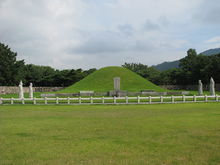Suro of Geumgwan Gaya
| Kim Suro 金首露 김수로 | |
|---|---|
 A modern take on King Suro's visage. | |
| King of Geumgwan Gaya | |
| Reign | 42? – 199 |
| Predecessor | Dynasty established |
| Successor | Geodeung of Geumgwan Gaya |
| Died | 199 |
| Spouse | Heo Hwang-ok |
| House | Kim |
| Suro of Geumgwan Gaya | |
 Tomb of King Suro in Gimhae | |
| Korean name | |
|---|---|
| Hangul | 수로왕 |
| Hanja | 首露王 |
| Revised Romanization | Suro-wang |
| McCune–Reischauer | Suro-wang |


Suro (수로) or Sureung (posthumous name: 수릉, 首陵, 42?–199), commonly called Kim Suro, was the legendary founder and Hero King of Geumgwan Gaya (43–532), in southeastern Korea.[1]
Legend[edit]
According to the founding legend of Geumgwan Gaya, which was recorded in the 13th century texts of the chronicle Garakguk-gi and was cited in Samguk Yusa, when the 9 Khans (9干) and their people[2] who were commanded by heaven performed ancestral rites, danced and sang, a gold bowl wrapped in red cloth came down from heaven. There were six eggs in them, and 12 days later six princes were born from the eggs.[2] Suro was the firstborn among them and led the others in setting up six states while asserting the leadership of the Gaya confederacy.[1][3]
Also according to legend, King Suro's wife, Heo Hwang-ok or Suriratna was a princess from a distant country called Ayuta 아유타, 阿踰, also implied to be in Southern India.[4][5]
The legend as a whole is seen as indicative of the early view of kings as descended from heaven. Notably, a number of Korean Kingdoms besides Gaya, made foundation legends with ties to chickens and eggs. Jumong, the founding King of Goguryeo, is said to have been born from an egg laid by Lady Yuhwa; Park Hyeokgeose, the first King of Silla (or Saro-guk) is said to have hatched from an egg discovered in a well; and Kim Al-chi, the progenitor of the Kim dynasty of Silla, is said to have been discovered in Gyerim Forest by Hogong in a golden box, where a rooster was crowing. Aspects of the legend have been mined for information about the customs of Gaya, of which little is known.[3]
Family[edit]
- Wife: Heo Hwang-ok
- 1st son: King Geodeung
- 2nd son: Prince Geochil of the Heo clan (거칠군 허씨, 居漆君 許氏)
- 3rd son: Prince Seongyeong of the Heo clan (선견왕자 허씨, 仙見王子 許氏)
- seven other sons (all become Buddhist monks: Haejin (혜진, 慧眞); Gakcho (각초, 覺初); Jigam (지감, 智鑑); Deungyeon (등연, 等演); Dumu (두무, 杜武); Jeonghong (정홍, 淨洪); Gyejang (계장, 戒莊))
- 1st daughter: Princess Yeongan (영안공주, 永安公主) – married Bae Yeolmun (배열문, 裴烈文).
- 2nd daughter: Lady Jijinnaerye of the Kim clan (지진내례부인 김씨, 只珍內禮夫人 金氏) – married Seok Guchu (석구추, 昔仇鄒).
Incorporation of tomb into the Silla ancestor worship[edit]
At the time of King Munmu, the spirit tablet of Suro was temporarily respected along with fellow Silla Kings, as Munmu was his 15th grandson. According to Samguk Yusa, Munmu ordered the Jesa of King Suro.
In modern culture[edit]
Tomb and descendants[edit]
A tomb attributed to King Suro is still maintained in modern-day Gimhae.[6][7] Members of the Gimhae Kim clan, who continue to play important roles in Korean life today, trace their ancestry to King Suro, as do the members of the Incheon Yi clan and Gimhae Heo clan; they did not inter-marry until the beginning of the 20th century.[8] A Memorial Park for Kim Suro and his wife Heo Hwang-ok is being built in Ayodhya, India jointly by South Korean Government and Indian Government to strengthen relationship between both countries on the grounds of history and cultural heritage. Ayodhya and Gimhae became sister cities in 2001.[9]
Television series[edit]
- Portrayed by Ji Sung and Park Gun-tae in the 2010 MBC TV series Kim Su-ro, The Iron King.[10]
See also[edit]
References[edit]
- ^ a b (in Korean) King Kim Suro Archived 2011-06-10 at the Wayback Machine at Britannica Korea
- ^ a b "김수로왕". terms.naver.com (in Korean). Retrieved 2021-05-02.
- ^ a b (in Korean) King Kim Suro Archived 2011-06-10 at the Wayback Machine at Encyclopedia of Korean Culture
- ^ Robert E. Buswell (1991). Tracing Back the Radiance: Chinul's Korean Way of Zen. University of Hawaii Press. p. 74. ISBN 978-0-8248-1427-4.
- ^ Skand R. Tayal (2015). India and the Republic of Korea: Engaged Democracies. Taylor & Francis. p. 23. ISBN 978-1-317-34156-7.
- ^ (in Korean) Tomb of King Suro at Doosan Encyclopedia
- ^ (in Korean) Tomb of King Suro Archived 2011-06-10 at the Wayback Machine at Encyclopedia of Korean Culture
- ^ (in Korean) Gim of Suro clan, Korean surname info
- ^ "Hundreds of South Koreans visit Ayodhya, India every year to pay homage to their ancestor Queen Suriratna".
- ^ Kim, Lynn (5 March 2010). "Ji Sung to star in new TV series Kim Su-ro". 10Asia. Retrieved 2013-02-15.
Bibliography[edit]
- Kwon, J.H. (권주현) (2003). Life and culture of the Gaya people (가야인의 삶과문화). Seoul: Hyean. ISBN 978-89-8494-221-9.
- Lee, K.-b.; E.W. Wagner; E.J. Schulz (1984). A new history of Korea. Seoul: Ilchogak. ISBN 978-89-337-0204-8.
- Lee, Hee Geun (이희근) (2005). Thematic history of Korea (주제로 보는 한국사). Seoul: Godswin. pp. 23–24. ISBN 978-89-91319-51-6.
External links[edit]
- Tomb of King Suro Life in Korea
- Gaya Culture Festival
- Kim Su-ro, The Iron King, TV drama from MBC
